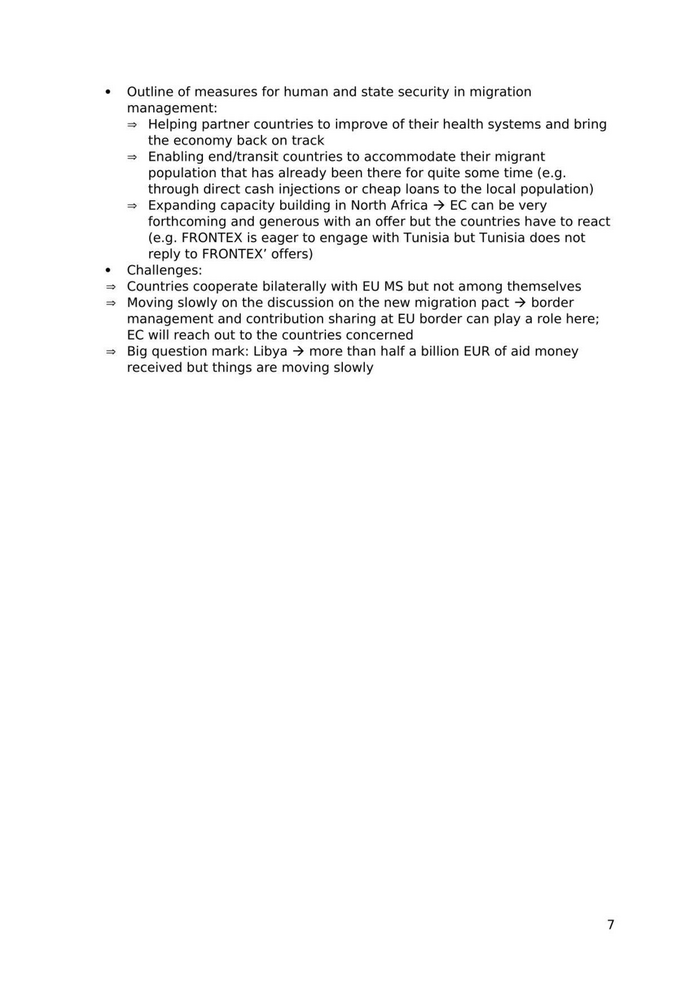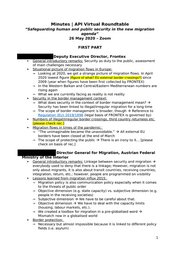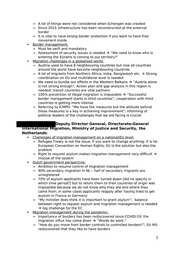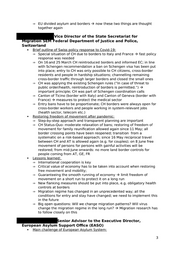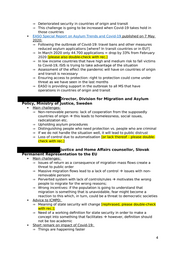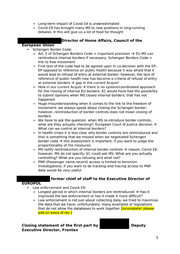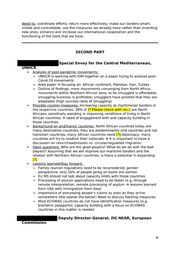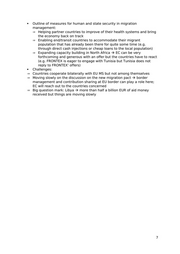Virtual_Roundtable_Minutes_May_2020
Minutes | API Virtual Roundtable “Safeguarding human and public security in the new migration agenda” 26 May 2020 - Zoom FIRST PART Deputy Executive Director, Frontex General introductory remarks: Security as duty to the public, assessment of main challenges necessary Situational picture of migration flows in Europe: > Looking at 2020, we get a strange picture of migration flows. In April 2020 lowest figure [figure of what? EU external border crossings?] since 2009 (year when figures have been first collected by FRONTEX) > Inthe Western Balkan and Central/Eastern Mediterranean numbers are rising again > What we are currently facing as reality is not reality Security in the border management context: > What does security in the context of border management mean? > Security has been linked to illegal/irregular migration for a long time > The scope of border management is broader, though > Reference to Regulation (EU) 2019/1896 (legal basis of FRONTEX is governed by) Numbers of illegal/irregular border crossings, third country returnees etc. [please check rec.] Migration flows in times of the pandemic: > “The unimaginable became the unavoidable.” > All external EU borders have been closed at the end of March > The scope of protecting the public > There is an irony to it... [please check on basis of rec.] BE rector General for Migration, Austrian Federal inistry O e Interior . General introductory remarks: Linkage between security and migration > everybody used to deny that there is a linkage; However, migration is not only about migrants, it is also about transit countries, receiving countries, integration, return, etc.; however, people are programmed on visibility Lessons learned from migration influx 2015: > Migration policy is also communication policy especially when it comes to the threats of public order > Objective dimension (e.g. state capacity) vs. subjective dimension (e.g. people in the receiving societies) > Subjective dimension > We have to be careful about that. > Objective dimension > We have to deal with the capacity limits (housing, labour markets, etc.). > We created a toolbox for migration in a pre-globalised word > Mismatch now in a globalised world Border protection: > Necessary but almost impossible because it is linked to different policy fields (i.e. asylum)
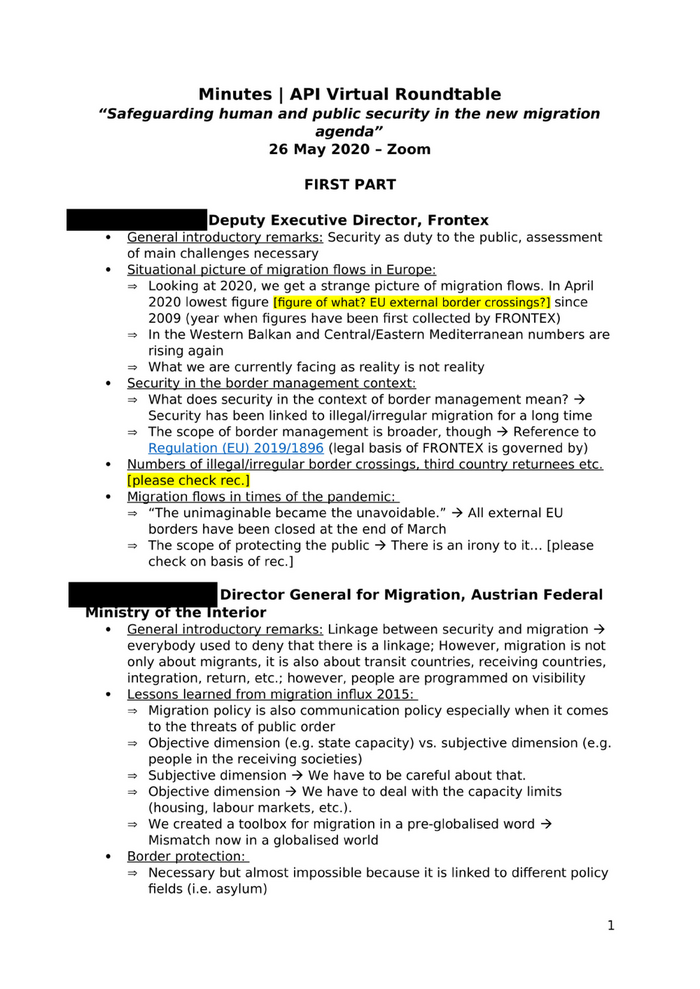
> Alot ofthings were not considered when Schengen was created > Since 2015 infrastructure has been reconstructed at the external => border It is vital to have strong border protection if you want to have free movement inside e Border management: = = Must be swift and mandatory Assessment of security issues is needed > “We need to know who is entering the EU/who is coming to our territory?” « Migration challenges in a globalised world: = = Austria used to have 8 neighbouring countries but now all countries around the world have become neighbouring countries A lot of migrants from Northern Africa, India, Bangladesh etc. > Strong coordination on EU and multilateral level is needed We need to bundle our efforts in the Western Balkans > "Austria alone is not strong enough”; Action plan and gap analysis in this region is needed; transit countries are vital partners 100% prevention of illegal migration is impossible > “Successful border management starts in third countries”; cooperation with third countries is getting more intense Referring to ICMPD: “We have the measures but the attitude behind those measures is a key in achieving improvement”; informing of political leaders of the challenges that we are facing is crucial Deputy Director General, Directorate-General E Ihrer Ministry of Justice and Security, the Netherlands: « Challenges of migration management on a national/EU level: => = Refugee Treaty is not the issue. If you want to change anything, it is he European Convention on Human Rights; EU is the solution but also the problem Right to request asylum makes migration management very difficult > misuse of the system «e Dutch government perspective: > = > Ambition to resume control of migration management 90% secondary migration in NL - half of secondary migrants are unregistered 70% of asylum applicants have been turned down [did he specify in which time period?] but to return them to their countries of origin was impossible because we do not know who they are and where they came from; in some cases applicants reapply after having tried to get asylum in France or Germany “My minister does think it is important to grant asylum”; balance between right to request asylum and migration management is needed > big challenge for the EC «e Migration management during the pandemic: > = Importance of borders has been rediscovered since COVID-19; the migration influx has come down > “Words do work.” “How do you move from border controls to controlled borders?”; EU MS rediscovered that they like to have borders
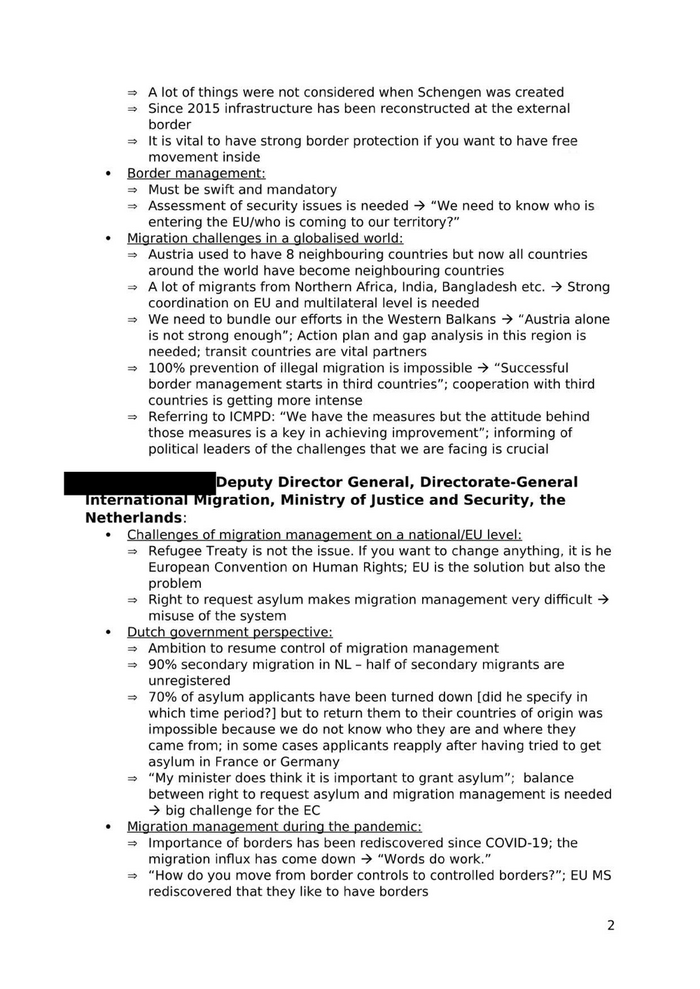
> EU divided asylum and borders > now these two things are thought together again a Director of the State Secretariat for ıgration ederal Department of Justice and Police, Switzerland Brief outline of Swiss policy response to Covid-19: = Special situation of CH due to borders to Italy and France > fast policy response was needed On 16 and 25 March CH reintroduced borders and informed EC; in line with Schengen recommendation a ban on Schengen visa has been put into place; entry to CH was only possible to CH citizens, cross-border residents and people in hardship situations; channelling remaining cross-border traffic through larger borders and closed the small ones CH was applying the existing Schengen rules (“In case of threat to public order/health, reintroduction of borders is permitted.”) > important principle; CH was part of Schengen coordination calls Canton of Ticino (border with Italy) and Canton of Geneva (border with France) > measures to protect the medical sector Entry bans have to be proportionate; CH borders were always open for cross-border workers and people working in system-relevant jobs (health sector, telecom etc.) Restoring freedom of movement after pandemic: = => Step-by-step approach and transparent planning are important CH Status-Quo: moderate relaxation of bans; restoring of freedom of movement for family reunification allowed again since 11 May; all border crossing points have been reopened; transition from a systematic on a risk-based approach; since 16 May reciprocal travel between CH and AT is allowed again (e.g. for couples); on 8 June free movement of persons for persons with gainful activities will be restored; from mid-June onwards: no more land border controls for people coming from AT, GE, FR Lessons learned: > > International cooperation is key Critical value of economy has to be taken into account when restoring free movement and mobility; Guaranteeing the smooth running of economy > limit freedom of movement on a short run to protect it on a long run New flanking measures should be put into place, e.g. obligatory health controls at borders Migration regime has changed in an unprecedented way; allthe conditions for entry and stay have changed; we need to implement this in the future Big open questions: Will we change migration patterns? Will virus change the migration regime in the long run? > Migration research has to follow closely on this enior Advisor to the Executive Director, European Asylum Support Office (EASO) Main challenge of European Asylum System:
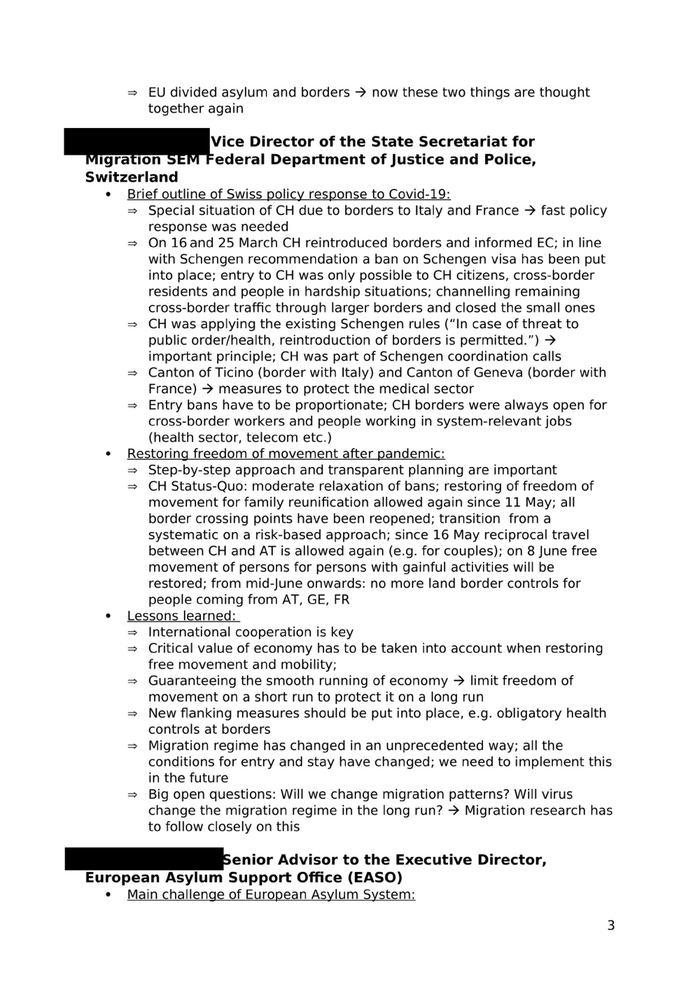
=> = Deteriorated security in countries of origin and transit This challenge is going to be increased when Covid-19 takes hold in those countries EASO Special Report on Asylum Trends and Covid-19 published on 7 May 2020: > Following the outbreak of Covid-19: travel bans and other measures reduced asylum applications [where? In transit countries or in EU?] In March 2020 only 44.700 applications = drop by 33% from February 2020 [please also double-check with rec.] In low income countries that have high and medium risk to fall victims to Covid-19, ISIS is trying to take advantage of the situation Assessment of the effect the pandemic will have on countries of origin and transit is necessary Ensuring access to protection: right to protection could come under threat as we have seen in the last months EASO is providing support in the outbreak to all MS that have operations in countries of origin and transit ana a Division for Migration and Asylum inistry of Justice, Sweden olicy, Main challenges: => U U U Non-removable persons: lack of cooperation from the supposedly countries of origin > this leads to homelessness, social issues, radicalization etc. Upholding asylum procedures Distinguishing people who need protection vs. people who are criminal If we do not handle the situation well, it will lead to public distrust Loss of control due to automatisation [or lack thereof - please double- check with rec.] na and Home Affairs counsellor, Slovak ermanent Representation to the EU Main challenges: > Issues of return as a consequence of migration mass flows create a threat to public order Massive migration flows lead to a lack of control > issues with non- removable persons Perverted system with lack of controls/rules > motivates the wrong people to migrate for the wrong reasons; Wrong incentives: if the population is going to understand that migration is something that is unavoidable, fear might become a reaction to this which, in turn, could be a threat to democratic societies Advice to ICMPD: > => Meaning of state security will change [rephrased, please double-check Need of a working definition for state security in orderto make a concept into something that facilitates > however, definition should not be too academic Short remark on impact of Covid-19: = Things are happening faster
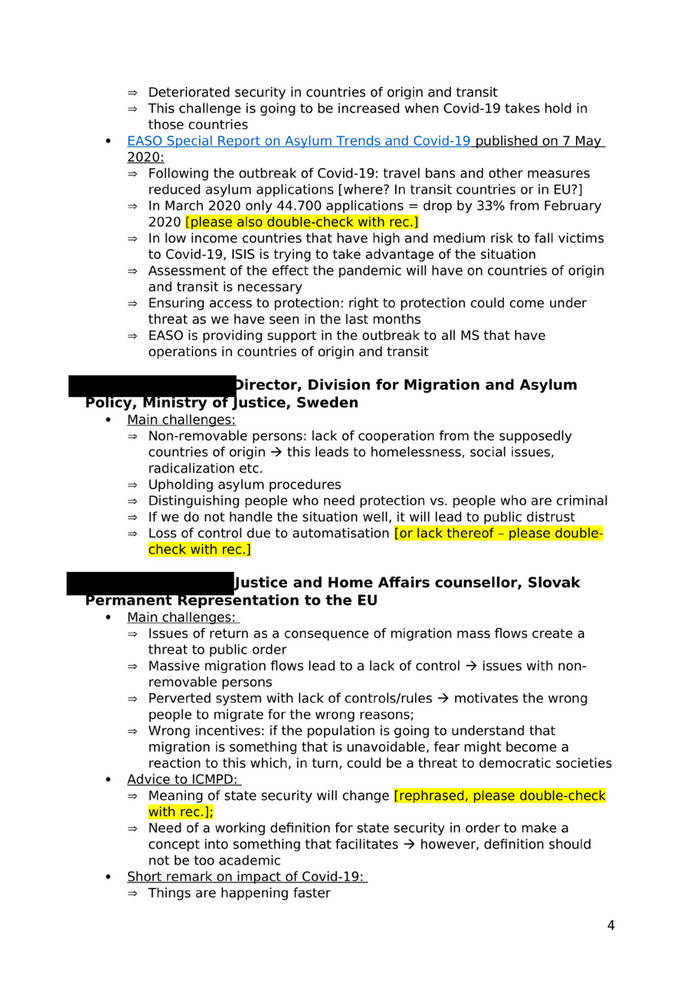
> Long-term impact of Covid-19 is underestimated > Covid-19 has brought many MS to new positions in long-running debates > this will give us a lot of food for thought ne of Home Affairs, Council of the uropean Union e Schengen Border Code: > Art. 2 of Schengen Borders Code = important provision > EUMS can reintroduce internal borders if necessary; Schengen Borders Code = link to free movement > First text of the code had to be agreed upon in co-decision with the EP; EP opposed to reference on public health because it was afraid that it would lead to refusal of entry at external border; however, the lack of reference of public health now has become a criteria of refusal of entry at external borders > gap in the current Acquis! > Hole in our current Acquis > there is no system/coordinated approach for the closing of internal EU borders; EC would have had the possibility to submit opinions when MS closed internal borders; that has not happened > Huge misunderstanding when it comes to the link to the freedom of movement: we always speak about closing the Schengen border; however, reintroduction of border controls does not mean closing of borders > We have to ask the question: when MS re-introduce border controls, what are they actually checking?; European Court of Justice decision > What can we control at internal borders? > In health crises it is less clear why border controls are reintroduced and that is something that we missed when we negotiated Schengen border code > this assessment is important, if you want to judge the proportionality of the measures > MS notify reintroduction of internal border controls > reason: Covid-19; however, MS do not specify; EC could ask MS: What are you actually controlling? What are you refusing and what not? > PNR (Passenger name record) access is limited to terrorism investigations; if you want to do tracking and tracing access to PNR data would be very useful ER on <: chief of staff to the Executive Director of EUROPOL « Law enforcement and Covid-19: > Longest period in which internal borders are reintroduced > Has it improved the law enforcement or has it made it more difficult? > Law enforcement is not just about collecting data; we tried to maximise the data that we have; unfortunately, many examples of regulations that do not allow the databases to work together [incomplete! please add on basis of rec.] Closing statement of the first part by Deputy Executive Director, Frontex
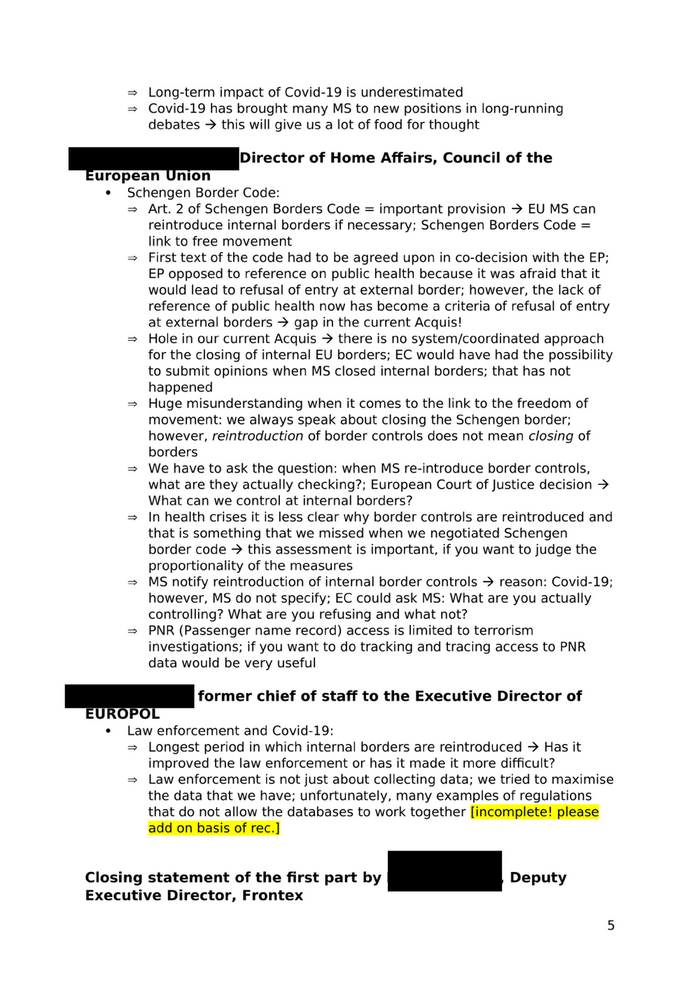
Need to: coordinate efforts; return more effectively; make our borders smart, visible and controllable; use the measures we already have rather than inventing new ones; enhance and increase our international cooperation and the functioning of the tools that we have. SECOND PART Special Envoy for the Central Mediterranean, UNHCR «e Analysis of post-pandemic movements: > UNHER is working with IOM together on a paper trying to analyse post- Covid-19 movements > Area paper is focusing on: African continent, Pakistan, Iran, Turkey > Outline of findings: more movements converging from North Africa; movements within Northern African area; to be smugoled is affordable; smuggling business is profitable; smugglers have proofed that they are adaptable (high success rates of smuggling) «e Possible counter-measures: Increasing capacity at maritime/air borders in the respective countries; 39% of [? Please check with rec.] are North Africans; sensitively assisting in improving conditions of living in North African countries > need of engagement with and capacity building in those countries «e Background on end/transit countries: North African countries today are many destination countries; they are predominantly end countries and not transition countries; many African countries need [?]-diplomacy; many countries will try to readmit their nationals > It is important to have a discussion on return/readmission vs. circular/regulated migration « Open questions: Who are the good players? What do we do with the bad players? Assuming that we will improve our maritime borders and the relation with Northern African countries, is there a potential in expanding [2] «e Lessons learned/Way forward: > Family reunion regulations need to be reconsidered; gender perspective: only 16% of people going on boats are women > EU MS should not talk about capacity limits with those countries > Processing of asylum applications need to be faster (e.g. through remote interpretation, remote processing of asylum > lessons learned from USA with immigration from Asia) > Importance of processing people’s claims as soon as they arrive somewhere (the sooner the better) Need to discuss flanking measures > Most ECOWAS countries do not have Identification measures (e.g. biometric passports); capacity building with a focus on ECOWAS countries in this matter is needed Deputy Director-General, DG NEAR, European Commission
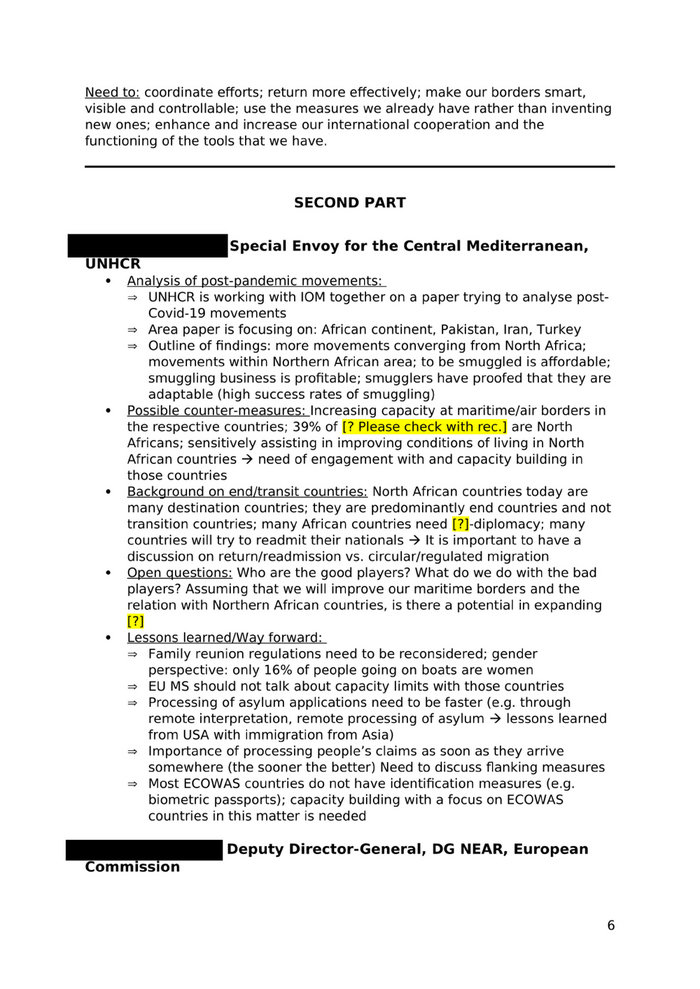
Outline of measures for human and state security in migration management: > Helping partner countries to improve of their health systems and bring the economy back on track > Enabling end/transit countries to accommodate their migrant population that has already been there for quite some time (e.g. through direct cash injections or cheap loans to the local population) > Expanding capacity building in North Africa > EC can be very forthcoming and generous with an offer but the countries have to react (e.g. FRONTEX is eager to engage with Tunisia but Tunisia does not reply to FRONTEX’ offers) Challenges: Countries cooperate bilaterally with EU MS but not among themselves Moving slowly on the discussion on the new migration pact > border management and contribution sharing at EU border can play a role here; EC will reach out to the countries concerned Big question mark: Libya > more than half a billion EUR of aid money received but things are moving slowly
